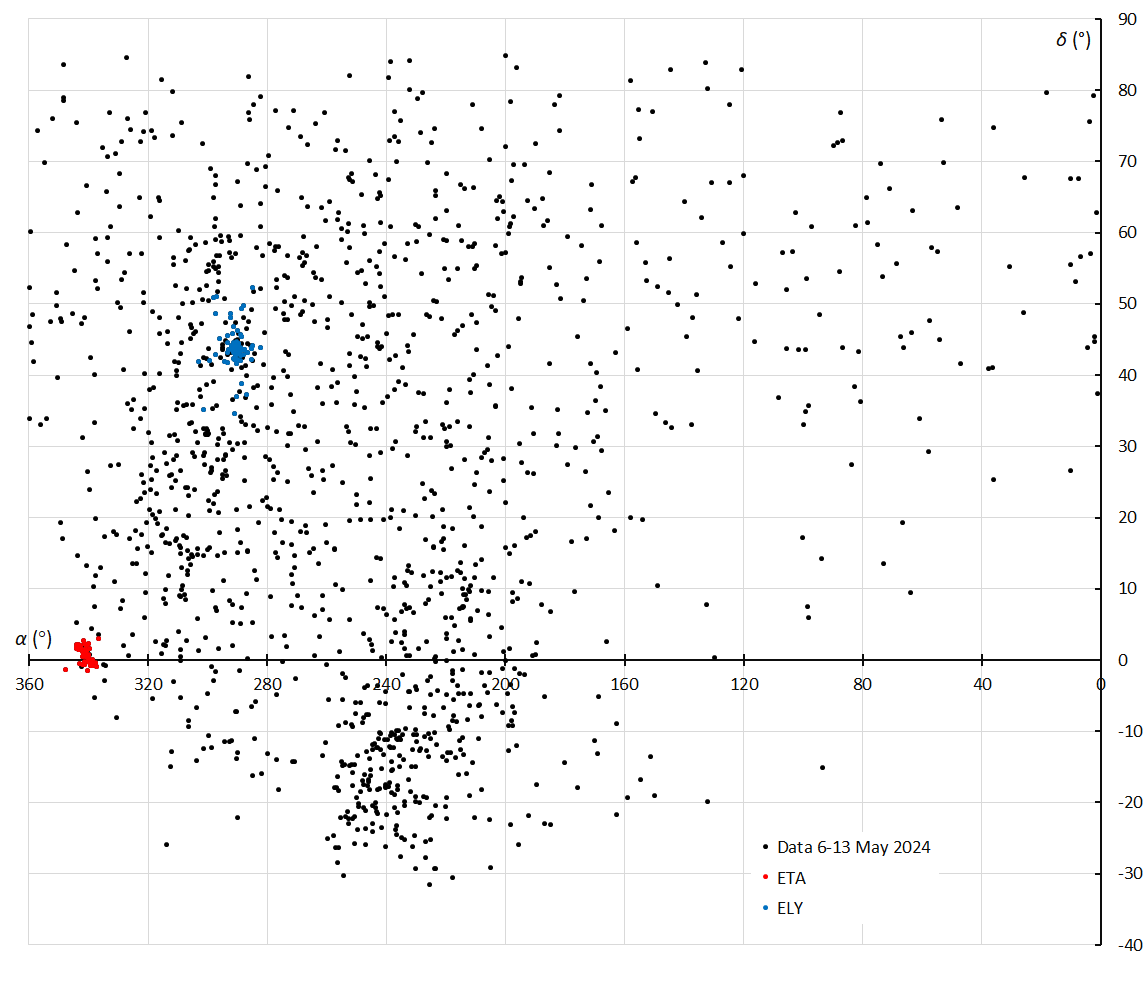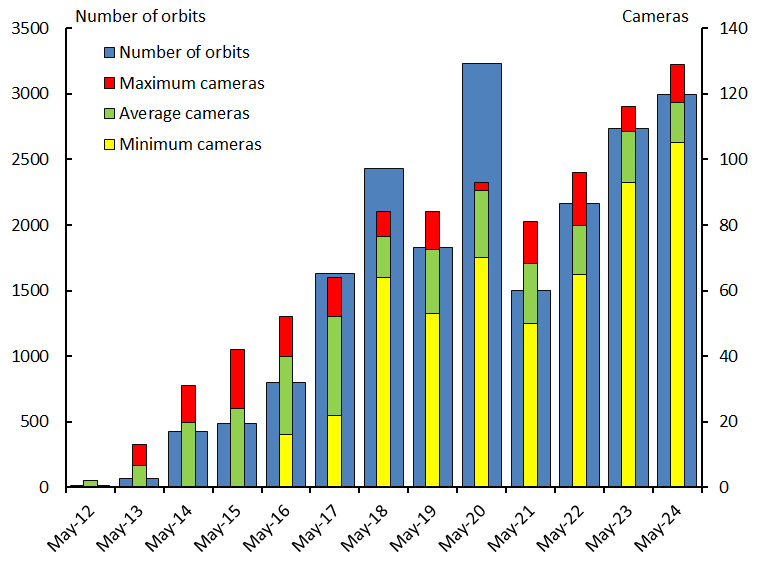Abstract: A summary of the activity of the CAMS-BeNeLux network during the month of May 2024 is presented. This month was good for 10084 multi-station meteors resulting in 2993 orbits.
Introduction
In addition to the ever-present sporadic activity, this month is best known for having one of the most active meteoroid streams in the Southern Hemisphere: the eta Aquariids (May 6). Even from our latitudes we can observe activity from this meteor shower.
May 2024 statistics
Fortunately, this month brought generally better conditions than what we got in the previous months. Especially during the second week of May we could collect many orbits, from May 6–7 up to May 13–14 a total of 1523 orbits.
Around May 14, weather resumed the cloudier pattern we faced already so many months since October last year. This trend was confirmed by the fact that only in 2 nights during the second half of May we could collect more than 100 orbits. A poor result compared with 10 nights with more than 100 orbits in the first half of May.
CAMS-BeNeLux collected a total of 10084 multi-station meteors, resulting in 2993 orbits. More than 50% of this score was achieved in the first half of May.
On average, 117 cameras were active during each night. On May 8–9, 129 cameras picked up data, in other nights at least 105 cameras (Table 1 and Figure 2).
The beautiful weather in the period 6 to 13 May also allowed that we were able to capture quite a few eta Aquariids. In Figure 1 all radiant positions of the 1523 orbits collected from May 6 up to May 14 are plotted. Red colored radiant positions refer to eta Aquariids meteors (ETA).
But we also see a concentration of radiants near RA = 285° and Decl. = 43°.These meteors belong to the eta Lyrid meteoroid stream (ELY), active from May 5–15 (Jenniskens, 2023), which coincided with exactly the period with clear skies in our regions. Meteor shower identification was done using of the Drummond criterium.

Figure 1 – Radiantpositions of all simultaneous meteors during May 6–14 (data CAMS-BeNeLux).

Figure 2 – Comparing May 2024 to previous months of May in the CAMS-BeNeLux history. The blue bars represent the number of orbits, the red bars the maximum number of cameras capturing in a single night, the green bars the average number of cameras capturing per night and the yellow bars the minimum number of cameras.
Table 1 – Number of orbits and active cameras in CAMS-BeNeLux during the month of May in the period 2012–2024.
| Year | Nights | Orbits | Stations | Max. Cams | Min. Cams | Mean Cams |
| 2012 | 5 | 13 | 4 | 2 | – | 2 |
| 2013 | 13 | 69 | 9 | 13 | – | 6.8 |
| 2014 | 22 | 430 | 13 | 31 | – | 19.7 |
| 2015 | 25 | 484 | 15 | 42 | – | 24.2 |
| 2016 | 26 | 803 | 17 | 52 | 16 | 39.9 |
| 2017 | 24 | 1627 | 19 | 64 | 22 | 52.0 |
| 2018 | 31 | 2426 | 21 | 84 | 64 | 76.6 |
| 2019 | 29 | 1825 | 20 | 84 | 53 | 72.4 |
| 2020 | 29 | 3226 | 24 | 93 | 70 | 90.5 |
| 2021 | 28 | 1500 | 25 | 81 | 50 | 68.2 |
| 2022 | 30 | 2160 | 28 | 96 | 65 | 79.8 |
| 2023 | 30 | 2734 | 36 | 116 | 93 | 108.6 |
| 2024 | 31 | 2993 | 45 | 129 | 105 | 117.4 |
| Total | 262 | 20290 |
Conclusion
This month gave the second-best result of all months of May so far. Only in May 2020 we could collect more orbits (3226). Most clear nights were around the ETA-maximum then.
Acknowledgment
Many thanks to all participants in the CAMS-BeNeLux network for their dedicated efforts. The CAMS-BeNeLux team was operated by the following volunteers during the month of May 2024:
Stéphane Barré (Colombey-Les-Belles, France, RMS 3907), Hans Betlem (Woold, Netherlands, Watec 3071, 3072, 3073, 3074, 3075, 3076, 3077 and 3078), Felix Bettonvil (Utrecht, Netherlands, Watec 376), Jean-Marie Biets (Wilderen, Belgium, Watec 3180, 3181, 3182 and 3183), Ludger Boergerding (Holdorf, Germany, RMS 3801), Günther Boerjan (Assenede, Belgium, RMS 3823), Martin Breukers (Hengelo, Netherlands, Watec 320, 321, 322, 323, 324, 325, 326 and 327, RMS 319, 328 and 329 ), Jean Brunet (Fontenay le Marmion, France, RMS 3911), Seppe Canonaco (Genk, RMS 3818 and 3819), Pierre de Ponthiere (Lesve, Belgium, RMS 3816 and 3826), Bart Dessoy (Zoersel, Belgium, Watec 804, 805, 806), Tammo Jan Dijkema (Dwingeloo, Netherlands, RMS 3199), Jürgen Dörr (Wiesbaden, Germany, RMS 3810), Isabelle Ansseau, Jean-Paul Dumoulin, Dominique Guiot and Christian Wanlin (Grapfontaine, Belgium, Watec 814, 815, RMS 3817, 3843, 3844 and 3845), Uwe Glässner (Langenfeld, Germany, RMS 3800), Roel Gloudemans (Alphen aan de Rijn, Netherlands, RMS 3197), Luc Gobin (Mechelen, Belgium, Watec 3890, 3891, 3892, 3893 and 3894), Tioga Gulon (Nancy, France, Watec 3900 and 3901), Tioga Gulon (Chassignolles, France, RMS 3910), Robert Haas (Alphen aan de Rijn, Netherlands, Watec 3160, 3161, 3162, 3163, 3164, 3165, 3166 and 3167), Robert Haas (Texel, Netherlands, Watec 811 and 812), Kees Habraken (Kattendijke, Netherlands, RMS 3780, 3781, 3782 and 3783), Klaas Jobse (Oostkapelle, Netherlands, Watec 3030, 3031, 3032, 3033, 3034, 3035, 3036 and 3037), Carl Johannink (Gronau, Germany, Watec 3100, 3101, 3102), Reinhard Kühn (Flatzby, Germany, RMS 3802), Hervé Lamy (Dourbes, Belgium, Watec 394 and 395, RMS 3825, 3841, 3895, 3896, 3897 and 3898), Hervé Lamy (Humain, Belgium, RMS 3821 and 3828), Hervé Lamy (Ukkel, Belgium, Watec 393 and 817), Hartmut Leiting (Solingen, Germany, RMS 3806), Arnoud Leroy (Gretz-Armainvielliers, France, RMS3909), Horst Meyerdierks (Osterholz-Scharmbeck, Germany, RMS 3807), Koen Miskotte (Ermelo, Netherlands, Watec 3051, 3052, 3053 and 3054), Pierre-Yves Péchart (Hagnicourt, France, RMS 3902, 3903, 3904, 3905, 3906 and 3908), Holger Pedersen (Otterup, Denmark, RMS 3501), Eduardo Fernandez del Peloso (Ludwigshafen, Germany, RMS 3805), Tim Polfliet (Gent, Belgium, Watec 396, RMS 3820, 3840 and 3846), Steve Rau (Oostende, Belgium, RMS 3822), Steve Rau (Zillebeke, Belgium, Watec 3850 and 3852, RMS 3851 and 3853), Paul and Adriana Roggemans (Mechelen, Belgium, RMS 3830 and 3831, Watec 3832, 3833, 3834, 3835, 3836 and 3837), Jim Rowe (Eastbourne, England, RMS 3703), Philippe Schaack (Roodt-sur-Syre, Luxemburg, RMS 3952), Romke Schievink (Bruchhausen Vilsen, Germany, RMS 3808 and 3809),Hans Schremmer (Niederkruechten, Germany, Watec 803), Rob Smeenk (Assen, Netherlands, RMS 3196), Rob Smeenk (Kalenberg, Netherlands, RMS 3192, 3193, 3194 and 3195), Erwin van Ballegoij (Heesh, Netherlands Watec 3148 and 3149), Andy Washington (Clapton, England, RMS 3702).
References
Jenniskens P. (2023). Atlas of Earth’s Meteor Showers, pages 55–57.




